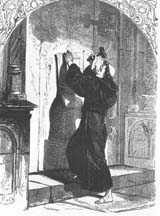#4: The Bubonic Plague
According to http://www.byu.edu/ipt/projects/middleages, the Bubonic Plague, aka The Black Death. began in China during the 1330's when fleas on disease infested rodents transferred the disease onto the Chinese. Victims of the disease experienced swollen lymph glands (buboes) as well as black spots that covered their skin.
However, the epidemic did not stay in China. Because China was a main trading center, ships traveled from there to other parts of the globe. As a result, a quick and forceful spread of the disease across Asia and Europe inevitably ensued. Europe's outbreak started when in 1347, dying men were found on an Italian ship that docked in Italy after a voyage to the Black Sea. The disease quickly spread across Italy and the rest of Europe, chaos spread alongside it. Abandonment of loved ones, requests for wills were rejected by fearful lawyers, corpses in houses without proper burial were only a few horros that accompanied the plague. Even the Italian writer Bocaccio, who is discussed in Fang's book, provided his own account of the deadly situation.
When Europeans believed the end of the plague had come with winter, they were struck with another wave during the springtime. They were ignorant of the fact that the disease- transferring fleas roamed only during the agreeable weather conditions. This deadly cycle continued adamently for the next five years until a third of the European population were dead. From a healthy population of 75 million to 50 million in 1352, a whopping twenty five million had been killed by the disease. In fact, the disease lingered along with the constant apprehension of another hard wave, until its complete disappearance in the 1600's.
Following the devestating outbreak, society experienced the beginning of more mayham with Peasant Revolts and a questioning of Chrisitanity. Because the demand for higher wages were not met, peasants across Europe began to revolt. Also, because prayers to be rescued from the plague had gone ignored, Christians were frustrated.
It was a turbulent Europe indeed and there were even more events that added to the chaos: The Hundred Years War, the Crusades, the Great Schism, etc. Even, as Fang writes, food shortages, a new money economy, lawless terrorist knights provided further destructive problems for Europe. With all this depressing social unrest, Europe needed some kind of solid and exciting social change. This was produced with the power of revolutionary printing to fuel new ideas for a Reformation and Renaissance. With this article, I was able to relate information discussed in class along with details written by Fang's Chapter 2, to form a clearer picture of the the aftermath of the Plague in terms of creating psychological disturbance, decreasing population numbers, emphasizing a need for change, as well as a number of other effects.
However, the epidemic did not stay in China. Because China was a main trading center, ships traveled from there to other parts of the globe. As a result, a quick and forceful spread of the disease across Asia and Europe inevitably ensued. Europe's outbreak started when in 1347, dying men were found on an Italian ship that docked in Italy after a voyage to the Black Sea. The disease quickly spread across Italy and the rest of Europe, chaos spread alongside it. Abandonment of loved ones, requests for wills were rejected by fearful lawyers, corpses in houses without proper burial were only a few horros that accompanied the plague. Even the Italian writer Bocaccio, who is discussed in Fang's book, provided his own account of the deadly situation.
When Europeans believed the end of the plague had come with winter, they were struck with another wave during the springtime. They were ignorant of the fact that the disease- transferring fleas roamed only during the agreeable weather conditions. This deadly cycle continued adamently for the next five years until a third of the European population were dead. From a healthy population of 75 million to 50 million in 1352, a whopping twenty five million had been killed by the disease. In fact, the disease lingered along with the constant apprehension of another hard wave, until its complete disappearance in the 1600's.
Following the devestating outbreak, society experienced the beginning of more mayham with Peasant Revolts and a questioning of Chrisitanity. Because the demand for higher wages were not met, peasants across Europe began to revolt. Also, because prayers to be rescued from the plague had gone ignored, Christians were frustrated.
It was a turbulent Europe indeed and there were even more events that added to the chaos: The Hundred Years War, the Crusades, the Great Schism, etc. Even, as Fang writes, food shortages, a new money economy, lawless terrorist knights provided further destructive problems for Europe. With all this depressing social unrest, Europe needed some kind of solid and exciting social change. This was produced with the power of revolutionary printing to fuel new ideas for a Reformation and Renaissance. With this article, I was able to relate information discussed in class along with details written by Fang's Chapter 2, to form a clearer picture of the the aftermath of the Plague in terms of creating psychological disturbance, decreasing population numbers, emphasizing a need for change, as well as a number of other effects.




